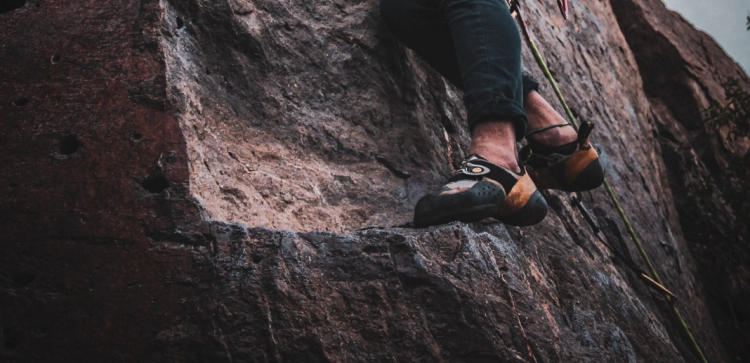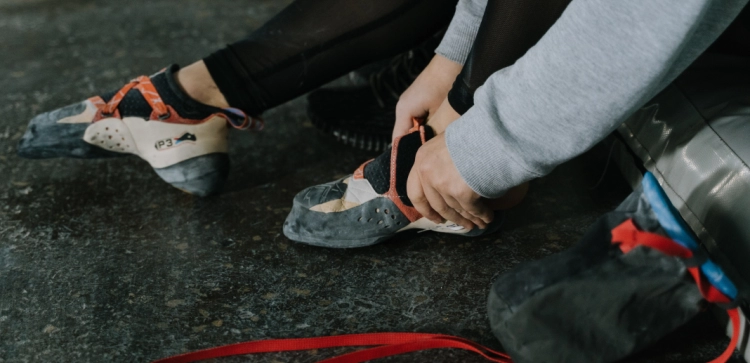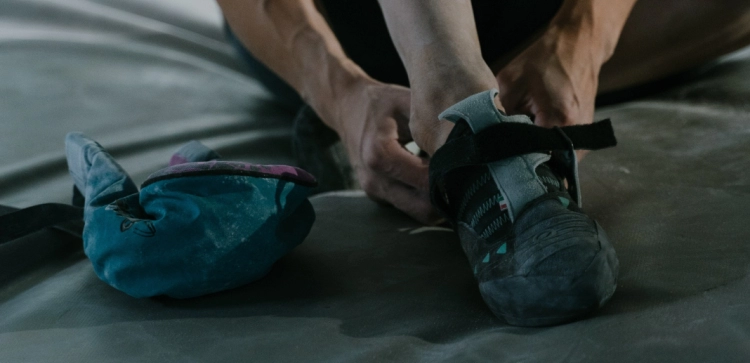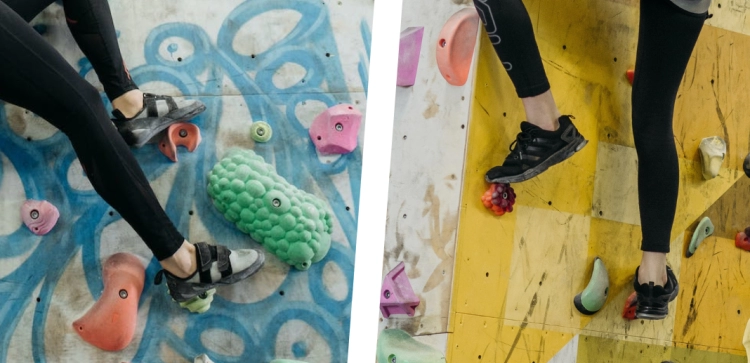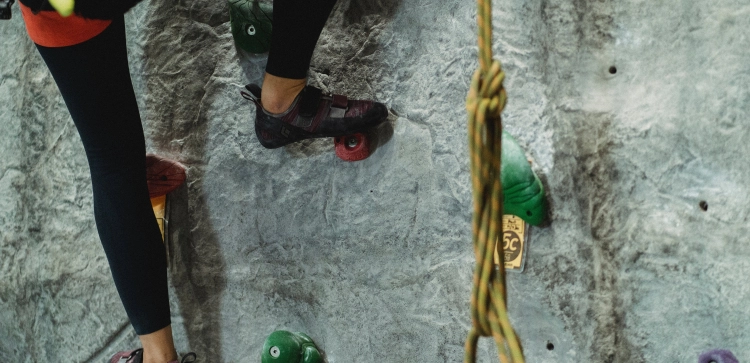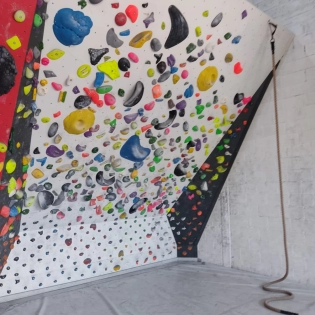Don't Downsize Climbing Shoes Before Understanding What It Means

Ask almost any climber, even beginners, and they will say that they have been told or have heard that they must downsize their climbing shoes in order to be a good climber and to climb difficult routes. This often gives the notion that smaller climbing shoes will make you a better climber.
While in some cases going down a size or two can in fact help when climbing very difficult routes, in many cases, this information is spread in the wrong context, or with no context at all. This misinformation can also lead to climbers buying shoes that are way too small for them, and even cause injuries.
Climbing shoes should only be downsized when and as needed. Downsizing climbing shoes can give specific performance boosts for climbers who are more experienced and can actually benefit from those performance boosts. If you are a beginner climber, there is no reason to downsize your climbing shoes, since you most likely will not benefit from these performance boosts.
So why do climbers wear climbing shoes that are a size down from their street shoe size, or even multiple sizes down, and how do you know when you should downsize your climbing shoes? This is what we are going to answer in this article. Before you buy climbing shoes that are too tight or too loose, make sure you read this article to ensure you are not causing yourself more harm than good!
- What Does It Even Mean To Downsize Climbing Shoes?
- Why Do Climbers Downsize Their Shoes?
- To Answer This Question, Let's First Take A Very General Look At Climbing Shoes.
- So Why Does Downsizing Matter If They Are Already Small And Tight?
- How Do I Know If I Should Downsize My Climbing Shoes?
- Why Do You Want A Smaller Size?
- Will Smaller Climbing Shoes Actually Help Solve Your Issue?
- Your Climbing Experience And Grade Matter
- How Much Should I Downsize My Climbing Shoes?
- Is This Your First Pair?
- Try On Multiple Sizes For A Comparison
- Speak To An Expert If You Are Struggling Or Have Questions
- How Do You Know If Your Climbing Shoes Are The Right Size
- Things To Remember When Sizing Climbing Shoes
- Climbing Shoes Stretch
- Climbing Shoes Differ From Brand To Brand
- Not All Shoes Fit All Feet
- Climbing Shoes Depend On Your Climbing Style
- Climbing Intensity, Level, And Frequency May Matter
- Trying On Vs. Climbing In Are Different
- A Shoe That Is Small May Not Equal A Shoe That Fits
- It's Not Supposed To Hurt
- It’s Not All About The Shoes Brand
- The Shoes You Want Just May Not Match Your Feet
- Going Up In Size Is Also A Thing
- Final Words On Downsizing
- Community Questions · 6
What Does It Even Mean To Downsize Climbing Shoes?
Downsizing climbing shoes means to wear climbing shoes that are a size or multiple sizes smaller than your normal street shoe size. Meaning, if you are a size 10 in your normal street shoes, in climbing shoes, you may wear a size 8 or 9 if you decide to downsize.
Why Do Climbers Downsize Their Shoes?
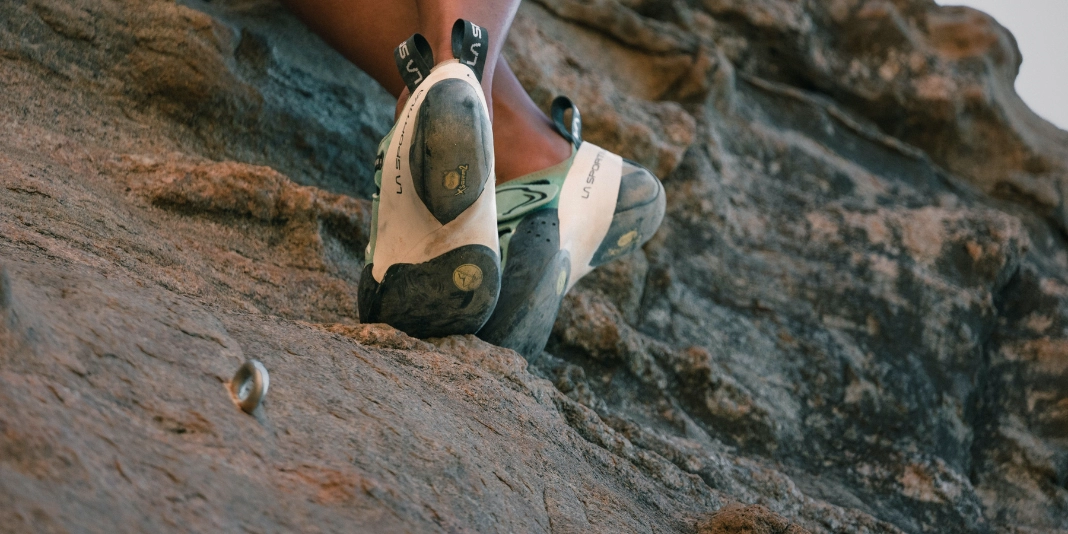
Downsizing climbing shoes gives more advanced climbers some performance boosts when it comes to foot work, control, and better support on climbing holds.
Buy why?
To Answer This Question, Let's First Take A Very General Look At Climbing Shoes.
Climbing shoes, by default, are oddly shaped and tight. In any case, you may need to downsize since a size 10 in street shoe size may be the equivalent to a size 9 in climbing shoes, depending on the brand. The reason for this is that you want to have as little space between your foot and the actual shoe, also known as dead space. This tightness helps climbers make the most out of the footwork and shoes. By being smaller, less bulky, and tight, climbers are able to have increased control over their feet placement and positioning, and to stand on very small foot holds that they would normally not be able to with your everyday shoes.
So Why Does Downsizing Matter If They Are Already Small And Tight?
The difference between day-to-day shoes and climbing shoes is a very big one, and the performance gains from wearing climbing shoes are very noticeable. These benefits can be amplified with downsizing, since it would mean that your climbing shoes are even tighter and that there is even less dead space between your feet and your shoes. This increase in tightness allows you to make sure that your feet do not move around in your climbing shoes, and that you are able to stand on extremely small foot holds, and that you have maximum control.
How Do I Know If I Should Downsize My Climbing Shoes?
Now that we understand what it actually means to downsize, let's take a look at when you should actually size down.
Why Do You Want A Smaller Size?
This is a pretty crucial piece of information. If you are sizing down just because you need new shoes and someone or multiple people told you that you need to size down, stop and actually think about it.
Think about what the purpose of sizing down is, and think if your reason for sizing down fits the purpose. If your current climbing shoes are comfortable, correctly sized, and you are climbing and advancing at a good pace, there may not be a need for you to downsize.
Going a size down in your climbing shoes, or multiple sizes down, can help give you a performance boost on some very difficult routes. If you are not at that level yet, or you are a beginner, then you may just not have a real need to size down, regardless of what others tell you.
Sizing down has become one of those unofficial truths in the climbing community. If someone hears that you have not sized down, they consider you a fool, but, it may in fact be them who are the fools if they have just sized down because others have told them to do so. They are just continuing the endless cycle of those who tell others to size down just for the sake of sizing down.
Their feet will be swollen and in pain, yours will not, and you will climb equally well as them, or even better.
Will Smaller Climbing Shoes Actually Help Solve Your Issue?
If you are sizing down because you actually think it will help your climbing, then think about when the last time was that you said to yourself, "I need smaller shoes".
Has this even happened? For many, it has not. But, they find themselves not able to finish a route, so they blame their shoes, when in fact it is their strength or technique or footwork specifically that needs work.
Try analyzing and paying attention to your climbing more, and the routes that you are not able to climb. Are your feet moving inside your shoes while you climb? Are your feet slipping inside your shoes? Are you not able to stand on small footholds? Think if getting a smaller shoe size will actually help solve the issues you are facing.
Also keep in mind that many routes, even v10 boulders, can be climbed barefoot, and with street shoes. Meaning, just the fact that you have climbing shoes on should give you a huge advantage over barefoot climbing or street shoes. If the routes can be done in those shoes, it can be done in your non-aggressively-downsized climbing shoes as well.
To emphasize this point, think about all of those climbers that warm on your project routes without climbing shoes on. If they can do it without wearing tiny climbing shoes, then you can do it also wearing your regular sized climbing shoes.
Your Climbing Experience And Grade Matter
If you are a beginner, there is no need to size down below what actually fits your feet. If you are climbing boulders of up to v4 or v5, there is still no real need to size down further than what fits.
Beginner climbers rarely need to size down, since they don't really reek the benefits of a smaller climbing shoe. Those who do are more advanced climbers that can actually take advantage of the smaller shoes and their benefits.
Climbers with more experience at some point understand that even without climbing shoes, they can still climb difficult routes. They understand that smaller climbing shoes only help for those specific routes that require extreme accuracy and tension from your feet. Routes in which you must be able to stand on micro foot holds, or put most or all of your weight on your feet, so your feet cannot move inside your shoes.
This is something that inexperienced climbers do not understand. If you can't take advantage of the benefits of smaller shoes, you don't need smaller shoes.
How Much Should I Downsize My Climbing Shoes?
Now that we understand what downsizing is and when you should downsize, we need to understand how much you should downsize. It is important to make sure that you are not getting shoes that are just too small for you to even put on without feeling throbbing pain.
Is this your first pair?
If these are your first pair of shoes that you will be buying, and you have decided that it is right for you to downsize, or you have worn rental shoes until now and have decided to invest in your own pair of climbing shoes, it is important to know what to expect, and to not try to go down to the smallest shoes you can stick your feet in.
Keep it simple. If they are your first pair of climbing shoes or your first shoes after rental shoes, even if you buy a size that is slightly too big, they will probably be better than your old shoes. This is especially true if you didn't have climbing shoes at all to begin with.
Try On Multiple Sizes For A Comparison
Don't just try on your street shoe size and 2 sizes smaller. Try on a few sizes. The sellers at the shop will usually prefer that you take the size that best fits you, they don't want to have to deal with so many climbers coming in asking for refunds or to change sizes. They won't mind bringing you as many sizes and models as you ask for.
Try on different sizes, and shoes from different brands also, and see which feels better to you. Walk around in them. If there is a climbing wall or a place to test them out, do it, see how they feel and how they support your feet, don't just settle for trying on one or two pairs from the same brand.
Speak To An Expert If You Are Struggling Or Have Questions
As mentioned, sellers really don't want to deal with climbers asking for refunds or to change their shoes to a different size after they bought them, and some don't allow it either. They would much rather you ask them and consult with them before you buy the shoes, and that is what they are there for also.
Ask someone who works at the place you will be buying your shoes from. Tell them what type of climbing you will be doing, whether it's bouldering, sport climbing, or what ever it is. They will most likely know how to help and guide you into buying the correct shoes for you.
How do you know if your climbing shoes are the right size
Having the right climbing shoe size isn’t always a matter of shoes being too tight, they can also be too loose.
Your Climbing Shoes Are Too Loose
Sometimes, climbing shoes may actually be too big, which is maybe not painful like having shoes too small, but it can actually be the cause of some injuries, and it can reduce climbing performance by quite a bit.
If, while you climb, you need to pull your weight on your heel, but your heel is moving in your shoe and popping out, this will reduce your climbing performance and control. This can even cause injuries if your foot actually does pop out of the shoe, or moves around too much inside and causes you to make a bad move that ends up spraining your foot.
Your Climbing Shoes Are Too Tight
While downsizing your climbing shoes can make sense, especially if they are leather shoes since they will eventually stretch and end up being a size or two bigger, there is such a thing as sizing down too much. If you just cannot put your shoes on, even with the plastic or paper bag trick, they may just be too tight.
If while wearing them you feel throbbing pain, or you cannot even walk in them, they may just be too tight. Some people fight and climb through the pain, and eventually the shoes may stretch out to be the size they want, but they usually have to suffer quite a lot of pain for that.
Keep this in mind next time you put on your shoes. Are you willing to climb through that pain, and is it really needed, or can you be equally good a climber with slightly bigger shoes?
Things To Remember When Sizing Climbing Shoes
When buying climbing shoes, there are a few things to remember that can help you make the right choice. Keeping these things in mind can help you decide which climbing shoes to buy and at what size. They can also help ensure that you will buy the correct type of shoe for your climbing style and purposes.
Climbing Shoes Stretch
Depending on the type of climbing shoes you buy, they may stretch quite a bit. Leather climbing shoes are known to stretch quite a bit, anywhere from one size to even 2 sizes or more for some. Synthetic climbing shoes on the other hand tend to either not stretch at all, or stretch only about half a size.
Keep this in mind while buying climbing shoes. If you buy synthetic climbing shoes and size down 2 sizes, expecting the shoes to stretch and be less painful, you may be disappointed, as this may just not happen. The shoes may not stretch at all, or they may not stretch enough for you to get that relief in pain.
The same goes with not taking into consideration that the shoes will stretch. If you buy shoes that are leather without considering that they probably will stretch, you may just end up with very baggy shoes in a few months.
Climbing Shoes Differ From Brand To Brand
Some time ago I ordered the climbing shoes Anasazi Pro, I did a lot of research using the different climbing communities to figure out which size I should get. Since the stores in my area did not have these shoes and I couldn’t try them on, I had to rely on the online community to get my answers. I also tried on other shoes that were said to have a similar fit to them, all to get the size I thought I needed. I ordered the shoes, and once they arrived, I was in for a disappointing surprise. Five Ten were bought by Adidas, and this purchase of the company led to a change in the shoe sizes. Meaning, a size 10 climbing shoe was no longer a size 10 after the purchase of the company, it had a smaller fit while still being labeled as a size 10.
The fact that I did not check this resulted in me getting shoes that were way too small for me to climb in. I could not walk in them, and I could barely even put them on.
The point in this story is that it is important to keep in mind that shoe sizes differ between brands. Size 10 shoes from one brand may not equal the size 10 of another brand. So if you usually climb in La Sportiva shoes and are considering getting shoes from a different brand, always try on the shoes, don't just expect the sizes to be the same.
Different brands have different fits.
Not All Shoes Fit All Feet
Feet come in all shapes and sizes, as do shoes, especially climbing shoes. This means that matching climbing shoes to some feet can prove to be a pretty difficult task.
If you have wide and flat feet, you may notice that most climbing shoes may not fit you very well. You may comprise on some areas, but as for general well fitting shoes, it can be very challenging to find a good pair.
So keep your feet in mind when deciding on climbing shoes. If the shoes just don't fit your feet well when you are trying them out, think about how it will be when you actually climb in them. This is especially true for synthetic climbing shoes, since they tend to not really stretch that much.
Do some research into climbing shoes that match your type of feet. It is very likely that other people in the climbing community have similar feet to yours, and they may have found shoes that do match their feet, and yours.
Climbing Shoes Depend On Your Climbing Style
Depending on the style of climbing you are buying shoes for, you may want to consider different climbing shoe types, and different sizes.
Aggressive climbing shoes are usually softer and used more for bouldering than long sport routes. Flat and stiff shoes are typically used more for long sport routes since they generally tend to be more comfortable and provide extra support for your feet, which may be crucial when climbing long routes.
If you downsize climbing shoes too much and end up climbing multi-pitches in them, you may find yourself in a world of foot pain.
Climbing Intensity, Level, And Frequency May Matter
If you are buying climbing shoes for everyday climbing, and not for intense all-out sessions on difficult routes, there may not be a reason to go down in size very aggressively. Sizing down even just one size could be enough, since the performance gains from tighter shoes will not really be needed.
Trying On Vs. Climbing In Are Different
If you have already bought climbing shoes, you may have noticed that how the shoes felt when you tried them on in the store are quite different from how they feel when you are wearing them and climbing in them.
Many stores have the option to try out the shoes, either because the store is in an actual climbing gym, or the store has a small climbing wall for you to test your shoes on. If the store you are buying your shoes from has this option, use it. Take advantage of it. This will help ensure that the shoes do in fact fit your feet and that the size is right. It's better to be sure, rather than finding out they don’t fit after you already bought them.
Keep this in mind while buying climbing shoes. Walk around in them, and try to climb in them a little bit to test them out if possible.
A Shoe That Is Small May Not Equal A Shoe That Fits
One of the most common questions people ask about climbing shoes is "how many sizes did you go down?", meaning, how many sizes below your street shoe size you went down.
The problem with this is that it creates a notion that climbing shoes must be sized down, as if the smaller you can go in climbing shoes, the better you will climb.
This is completely false and can be a source of a lot of pain. Smaller climbing shoes do not always equal better climbing, nor do they always equal a better fit.
It’s true that climbing shoes are small and tight to begin with, and that they should have the least amount of dead space as possible, but sizing down just for the sake of sizing down will not improve your climbing.
Just because you sized down 3 sizes from your street shoe size, does not mean it's a better fit than sizing down 1 size, or not sizing down at all.
It's not supposed to hurt
No matter what size you end up getting, your climbing shoes are not supposed to hurt.
Sure, there will be discomfort, whether you downsize or not, it's just the nature of climbing shoes, they are tight and uncomfortable. This can be amplified when downsizing, but even then, the shoes should not cause real pain that leaves your feet aching and throbbing after or while wearing them.
This is true for choosing the right climbing shoe size, but also for choosing the right climbing shoes in general, regardless of their size. Not all feet are the same, and not all climbing shoes fit all feet. Some shoes are made for narrow feet, while others are made for wider feet. Trying to wear climbing shoes that are just not made for your type of foot can just be even more uncomfortable and painful than necessary.
It’s Not All About The Shoes Brand
La Sportiva is probably the most popular climbing shoe brand. Their shoes are worn by climbers of all levels, from beginners to the elite.
But just because one particular brand the most used brand in your climbing gym, or even in the world, doesn't mean they are the best shoes for you. It doesn't mean you shouldn't go with shoes from a different brand. In the end, what will make the biggest difference to your climbing in terms of footwear is choosing shoes that fit you the best, regardless of the brand.
The Shoes You Want Just May Not Match Your Feet
As someone with wide and flat feet and small heels, I can tell you, finding the right climbing shoes can be very difficult. Many times, when climbers have some dead space in their heels, they think they just need to downsize more. While this may be the case in some situations, in others it may just mean that the shoe does not fit your foot, not in terms of size, but in terms of shape.
Going Up In Size Is Also A Thing
Though this is heard of much less than downsizing, I would even go so far as to consider it quite rare, some people may just benefit from upsizing their climbing shoes.
I am one of those who have a very difficult time finding climbing shoes that fit well, and by fit I mean that the shoe's shape matches my feet. I normally upsize half a size from my everyday shoes, I find that this is the only way I can actually wear climbing shoes. This is also a performance size for me, a comfort size would be 1 size larger than my everyday shoe size.
Like me, there are quite a few people who upsize their climbing shoes, though a clear minority in the climbing community, it does exist. So don't think that you must downsize your climbing shoes, it may very well be that you can just stay at your general shoe size, or even go up half a size or more.
Final Words On Downsizing
Sizing down your climbing shoes can help give you a better experience while climbing, and it can help give you that extra performance boost you sometimes need. But, there is also a red line that when crossed, your small climbing shoes no longer provide any benefits.
I have known quite a few climbers who fell in love with the sport, only to be demotivated to return to the gym because their feet were in agonizing pain. They heard that they need to downsize as much as possible, so they spent a lot of money on expensive and overly tight climbing shoes, and could barely get their feet in the shoes, let alone climb in them.
That is the kind of misinformation this article is meant to prevent. Hopefully, it has done its job, and it will give you the tools and information you need to make an educated decision on if downsizing is right for you, and how many sizes you should go down.
Let us know in the comments your day-to-day street shoe size vs. your climbing shoe size, and if you have had any bad experiences with downsizing too much.


